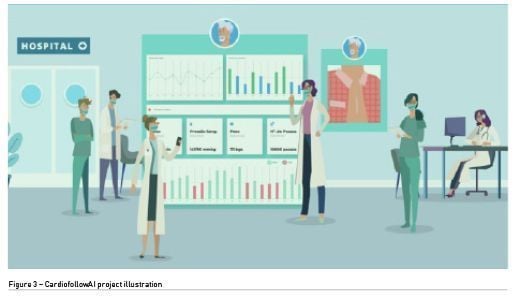HealthManagement, Volume 21 - Issue 6, 2021
An intelligent system to improve patients’ safety and remote surveillance in follow-up for cardiothoracic surgery
Key Points
- The design of a remote telemonitoring service must consider the diversity and variety of socioeconomic status of patients reducing the risk of inequity and inequality in the access to healthcare.
- Digitising a healthcare service requires a collaborative network of stakeholders that consider and perceive the value they add for the patient and the healthcare network.
- Digital healthcare service is the result of successive iterations of technologies and organisational models.
- Patients and healthcare professionals must be engaged from the beginning of the service design process to express their contexts, needs, fears, and motivations.
- Artificial intelligence can improve patients’ engagement and support clinical decisions by using technology based on risk stratification.
Introduction
Academia and government experts emphasise that to reach a sustainable universal healthcare coverage, it is crucial to identify the optimal allocation of resources and improve the quality of healthcare delivery. Although there has been an intense, fast, and dynamic progression in science and digital innovation in healthcare, the benefits of these investments to the overall system are not clear. The effort to digitise the healthcare system is under constant scrutiny due to a fragmented system that cannot demonstrate its potential value to all stakeholders. Consequently, exciting times and opportunities emerge for technology and innovation to meet and give structure to achieve a higher-quality, lower-cost healthcare system. Besides providing improved capacity to treat patients, remote care services, and new treatments for diseases, technology has the potential to give helpful information and include a diversity of perspectives to enlighten on the actual value inherent to all healthcare processes (Gray et al. 2017).
Digital Follow-up Care in Cardiothoracic Surgery
The commitment to universal health coverage, and the emergence to control the damage caused by COVID-19, demand a transformation of the healthcare system grounded on appropriate care and efficient use of resources. Moreover, digital technology can be the best adequate venue for collecting evidence and supporting decision-making across all levels and stakeholders of the system. However, recent research demonstrates that technology adoption is not at its maximum potential. Even with imposed social distance due to pandemics, why were we not ready to tackle the population healthcare needs with so much technology in our hands? The importance of having remote access to healthcare and facilitating a digital experience to patients and clinical teams has never been so evident as during this pandemic.
We designed and implemented a postoperative digital telemonitoring service for patients submitted to cardiac surgery in Hospital de Santa Marta. Hospital de Santa Marta, a central public hospital in Lisbon, Portugal, is a centenary and leading hospital in Cardiothoracic Surgery at both the national and international levels. With a successful phone-call-based follow-up service, the surgery team was motivated to improve the service to integrate vital signs and patient-reported outcomes collection to allow a better patient experience, earlier hospital discharge, and safer recovery at home. Furthermore, telemonitoring became particularly advantageous in the pandemic context, as it supports the continuity of care with minimal risk of transmission by avoiding unnecessary hospital visits and consultations.
The Relevance of Collaborative Networks to Deliver Value in Healthcare
Considering the European context and the values of societies committed to universal health coverage (UHC), a panel of experts (European Commission 2019) propose four values to healthcare systems, from previous contributions of Porter and Teisberg (2006) and Gray et al. (2017): Personal value, allocative value, technical value or utilisation value, and societal value. These four pillars require a transformation of the healthcare system by understanding what patients, healthcare professionals, healthcare providers, technology providers, payers, society and others value most.
The value-based healthcare paradigm has fomented the collaboration between experts from different fields to “fix the healthcare system”. Shortell (2008) foresaw that a healthcare system based on value, derived by outcomes, will drive the reconfiguration of the healthcare system into a network-based structure. Academia, industry, government, and non-governmental organisations dedicate their time and resources to cope with challenges and opportunities to improve the healthcare system. There is an ultimate desire to provide high-quality products and services to people seeking healthcare. Different interests, motivations, and definitions on healthcare quality and access must be considered to drive stakeholders to develop high-value services; otherwise, they will self-organise and compete for individual goals compromising results (Rouse 2000). The increased workload due to this practice, however, may be challenging to manage and biparametric MRI may prove a valuable optimisation in terms of acquisition time and exam scheduling in busy radiology departments. A study conducted in the United Kingdom reported a 55% reduction in scan time, significantly increasing the number of scans performed weekly (Sushentsev et al. 2020).
To address the aforementioned systemic issues, CardiofollowAI implemented a network to guarantee a high-value digital healthcare service. This network was promoted by Value for Health CoLAB, joining Fraunhofer AICOS, Vodafone Portugal, Nova Medical School and the Hospital de Santa Marta. After gathering the stakeholder’s motivations, expected benefits, and contributions, we defined a strategy that would leverage a value-based digital service.
- Value for Health CoLAB (VOH.CoLAB) is a non-profit research collaborative laboratory focused on developing and validating innovative methodologies to measure outcomes and costs that influence the health value of every person. The motivation to engage in the design of this new service was to advance knowledge in the design methodology of value-based, flexible, and low-cost remote digital healthcare services.
- Fraunhofer AICOS joined the project to enhance its investment efforts from their previous success in developing a digital health kit for remote monitoring of patients with chronic cardiac pathologies. The digital health kit consisted of a smartphone with SMARTBEAT app to collect data from a smartwatch (to measure steps and continuous heart rate), a sphygmomanometer (to measure blood pressure and heart rate), and a scale (to measure weight).
- Vodafone Portugal joined the project to promote the development of technological solutions that improve the quality of life of the community and develop new products and services in the health sector. Vodafone Portugal contributed with the 4G connection integrated into the kit to allow data exchange.
- NOVA Medical School and Hospital de Santa Marta support the clinical research and deployment of the digitised service. Hospital de Santa Marta as a university hospital has a strong background and motivation to collaborate with NOVA Medical School to train their medical students in new medical areas. These two organisations have been working to modernise existing services and prepare healthcare professionals to integrate cost-effective technology in clinical practice.
A Digital Experience that Provides Better Access to Healthcare
Patient follow-up is essential in the recovery of cardiac surgery patients, as hospital readmission rates are 15 to 20% in the first 30 days and 30% considering the first year. To tackle the risk of readmission, the goal of the RPM service is to empower patients to report symptoms from home and actively engage them in recovery. Also, the service must empower the clinical team to follow patients effectively.
We mapped a patient pathway to allow data collection in different timestamps to monitor the patient and control the quality, experience, feasibility of service, and technology performance. The clinical team was fundamental in specifying use cases and scenarios for cardiothoracic surgery digital remote follow-up service. Throughout several in-presence meetings, the research and the clinical teams exchanged knowledge using process maps to design the care process, define the outcomes to be measured and the required resources to assess these outcomes. After an iterative process, the protocol was validated by all stakeholders.
The primary commitment was to design a digital remote monitoring experience to quickly demonstrate how the patient and the clinical teams would be involved in a 30-day telemonitoring period.
In CardiofollowAI, we developed a system where patients generate data, i.e., patients are instructed to perform a daily routine to collect data. The reason for this was to promote patients’ engagement in recovery, making them aware of the process. Usability of the technology and literacy of the patients is a determinant factor in the success of such an approach. The daily remote monitoring routine of the patient consists of measuring the vital signs using a sphygmomanometer and a scale, using a smartwatch to count steps and measure pulse rate, answering five multiple-choice questions about symptoms, and taking a picture of the surgical wound to send via a chatbot. Every day, the nurses monitor this data in a web-based monitoring platform. In case of unexpected variations, the nurse contacts the patient to assess the patient’s health status or discusses the clinical case with the surgery team.
As nurses must spend extra time analysing each patient’s reported data, the high burden associated with more patients demanded an agile system that would allow an overview of all patients’ health statuses with alerts to call for attention for specific abnormal parameters and allow a more detailed description of each patient. That was how Beatnik was created in co-creation with the clinical team — a web-based remote telemonitoring management system interoperable with the IoT devices and the chatbot.
After several iterations, Beatnik allows nurses and surgeons to quickly assess each patient’s health status (vital signs, symptoms, and wound cicatrisation), take notes, and change therapy.
More recently, based on patients’ and clinical team’s feedback, another opportunity for development emerged: provide feedback to patients using a chatbot. As the chatbot integration was very successful, since most of the patients were using this channel for communication, nurses looked to the opportunity of interacting with patients more frequently. This chatbot sends automatic messages with health literacy content pre-defined by the nurses and triggered by specific events.
Digital Health Literacy
Literature in digital health has consistently highlighted the importance of patients and their caregivers as active members in the development cycle. More specifically, they should be informed and involved in the design of new digital health services. Therefore, our approach to improving the digital health literacy of the patients started on the day of hospital discharge. An individual session with the patient, caregiver and nurse was organised to explain the project, assess the patient’s will to participate and deliver the digital health kit. We simulated a daily routine, and the nurse discussed the relevance of the measures for a safe recovery.
A Further Step with AI: Supporting Decisions Based on Risk Prediction and Intelligent Interaction
After a successful pilot study, the telemonitoring service faces the challenge of optimising the follow-up process, with results from the telemonitoring pilot and the outcomes from the 1-year follow-up programme. Data integration would allow identifying patients at higher risk of complications or readmissions to support decisions on follow-up resources that maximise patient safety.
In the CardiofollowAI project, funded by the Portuguese National Foundation of Science and Technology, we are now working in machine learning algorithms to develop risk prediction models based on patients’ data. These models will support decisions that are related to the telemonitoring needs and resources. We are posing the hypothesis that patients with a higher risk of complications during the first year after surgery are those who will most benefit from the digital remote telemonitoring service.
We are also developing intelligent interaction between patients and nurses, considering patient-reported outcomes, literacy, and other particular needs. Intelligent interaction implemented in the chatbot and the clinical telemonitoring platform will allow personalised support to each patient’s recovery pathway.

Conclusion
Digital health services are an opportunity to cope with challenges related to lack of capacity, isolated population, and low access to high-quality healthcare. These services’ inherent technological basis allows evidence-based, efficient, and more effective development and integration iterations. The work conducted so far motivated the collaborative network to apply for large-scale pilot project funding.
The main goals include developing an Artificial Intelligence-based decision support system for resource allocation to maximise long-term health outcomes and studying the service’s macroeconomic impact. The proposal was granted funding, and all stakeholders are involved in a 2-year research project.
Based on Lean Startup’s principles and Design Science Research Methodology, our approach to design and develop a new digital health service allowed all agents involved to be creative and give contributions without compromising resource and budget constraints. It also enabled the demonstration of value in short cycles of development and real-context validation.
Conflict of Interest
None.
References:
European Commission (2019) Defining value in “value-based healthcare”: report of the Expert panel on effective ways of investing in health (EXPH). Available from publications.europa.eu/publication/manifestation_identifier/PUB_EW0419516ENN
Gray, JAM et al. (2017) How to get better value healthcare. 3rd edition. Offox.
Porter ME, Teisberg EO (2006) Redefining health care: creating value-based competition on results. Boston, Mass: Harvard Business School Press.
Rouse W (2000) Managing Complexity: Disease Control as a Complex Adaptive System. Information Knowledge Systems Management, pp. 143–65.
Shortell SM (2008) Health Care Reform Requires Accountable Care Systems. JAMA, 300(1), 300(1):951. doi: 10.1001/jama.300.1.95.






